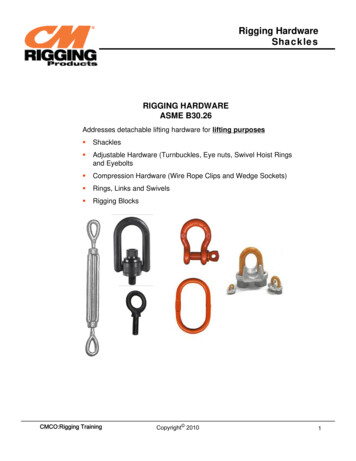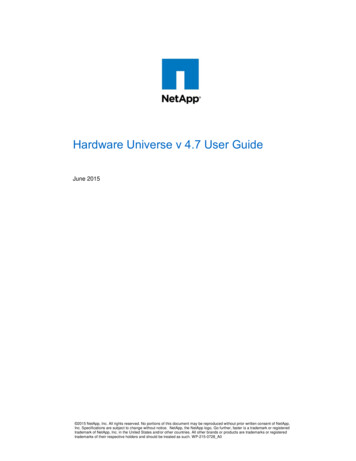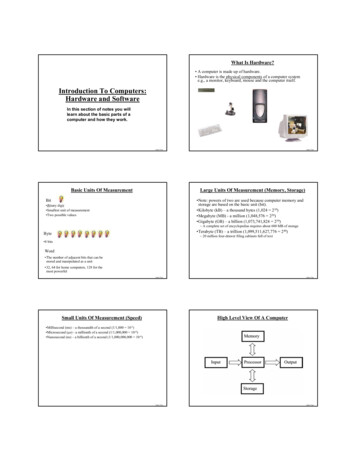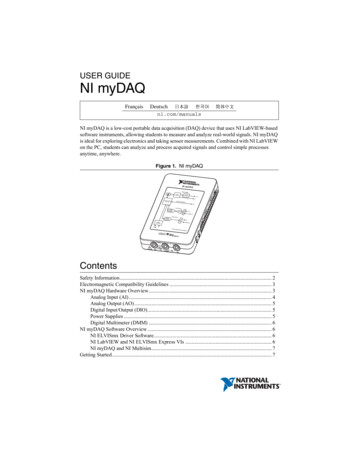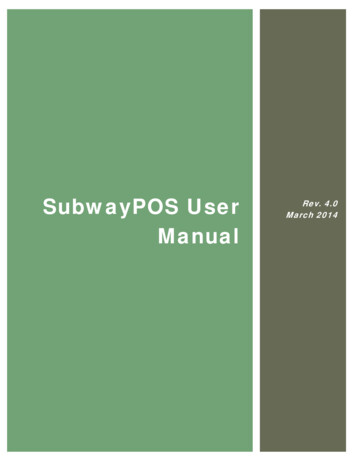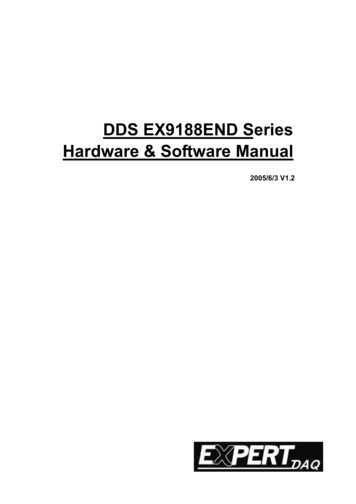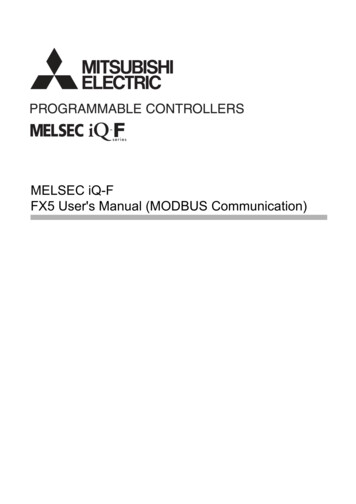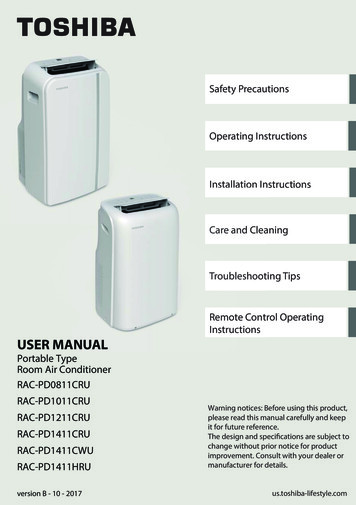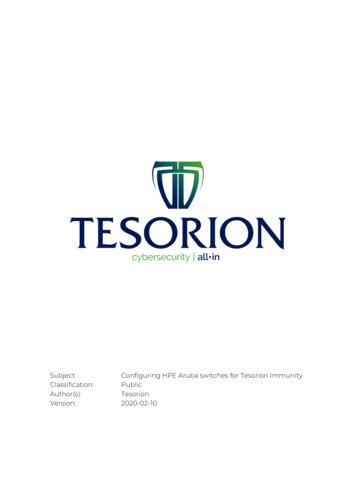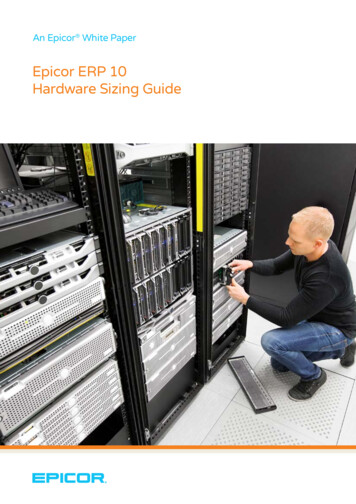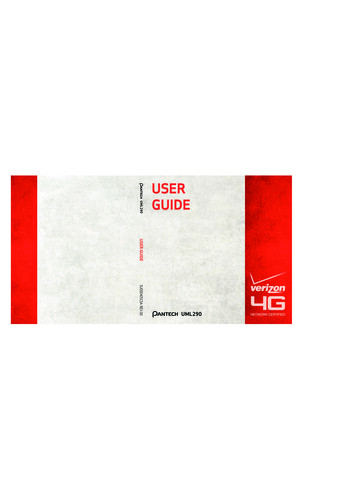
Transcription
User Manual(Hardware)UML290
CHAPTER 1BEFORE USING UML290.3ABOUT THIS USER MANUAL.4PRODUCT OVERVIEW.4WHAT’S INSIDE THE PRODUCT PACKAGE.4INTRODUCTION TO WIRELESS UML290 USB MODEM.5PRODUCT FEATURES.6PRODUCT HANDLING.7CONFIGURATION.7CHAPTER 2INSTALLING UML290.9PRECAUTIONS.10RECOMMENDED SYSTEM REQUIREMENTS.10INSTALLING THE 4G SIM CARD.11REMOVING THE 4G SIM CARD.11INSTALLING VZACCESS MANAGER.12INSERTING AND REMOVING UML290. 13USB MODEM EXTENSION CABLE ACCESSORY. 14BEFORE USING UML290ABOUT THIS USER MANUALPRODUCT OVERVIEWWHAT’S INSIDE THE PRODUCT PACKAGEINTRODUCTION TO WIRELESS UML290 USB MODEMPRODUCT FEATURESPRODUCT HANDLINGCONFIGURATIONCHAPTER 3REGULATORY AND SAFETY INFORMATION .15REGULATORY NOTICES.16OPERATING CONDITIONS.16WARNINGS AND CAUTIONS.17SAFETY PRECAUTIONS .19CHAPTER 4APPENDIX.21GLOSSARY.22SPECIFIC ABSORPTION RATES (SAR).25SAFETY INFORMATION FOR RF EXPOSURE.26DECLARATION OF CONFORMITY (R & TTE).2821UML290
BEFORE USING UML290ABOUT THIS USER MANUALYou will find all the information you need to install and use the UML290 in this user manual. Beforeusing the UML290, you must properly install the UML290 software by closely following the installationinstructions that came on the VZAccess Manager Software User Manual in the Installation CD. RF Brochure ICI Brochure Product Safety & Warranty Guide VZAccess Manager CD ROM (including User Guides)INSTRUCTIONSINTRODUCTION TO WIRELESS UML290 USB MODEM Install the VZAccess Manager software and drivers before using the UML290 USB Device with yourcomputer. The installation software is included on the VZAccess Manager CD. Installation may take afew minutes. It is highly recommended that you read the safety precautions described in this manual before usingthe UML290.By inserting the VZAccess Manager CD you will find all the software you need to get started and alsolearn all about setting up your GlobalAccess wireless device.The Verizon Wireless UML290 is designed for your computer’s USB port, which is available in mostmodels. The UML290 can be used to access the Internet, your company’s intranet, or you can use itto send and receive email. It is extremely useful when you are away from the office, on the road, orwherever a wireline Internet access is not readily available. Important: If using a USB device, VZAccess Manager software must be installed before you insertthe USB device into the computer for the first time. Only after the software has been installed canWindows successfully install and configure the USB device.152PRODUCT OVERVIEWThank you for purchasing the Verizon Wireless UML290 USB Modem. The UML290 is a 4G wirelessdevice that enables high-speed wireless communication from your computer. The UML290 is simple toinstall and use.WHAT’S INSIDE THE PRODUCT PACKAGEThe following items are included in the product package. If any of the items listed below are missing,please contact the retail location where you purchased the product. UML290 Wireless USB Modem USB Modem Extension Cable Quick Reference Guide4341. L ED status indicator:Blue light Connected to computer anddetected by network.Red light Connected to computer butnot in service area.2. Cover: Rotate the cover right to accessUSB Connector. Leave cover open for bestreception.3. USB Connector4. SIM Card Slot: Positioned at the back ofthe USB modem.5. External Antenna Adapter Jack:For better reception, plug in externalantenna booster here.** External Antenna Adapter sold separately.5
BEFORE USING UML290 For optimal reception, keep the cover open at a ninety degree angle.Closing the cover will block the intenna, minimizing network access.PRODUCT FEATURES Power management: The UML290 utilizes power management and system overhead reductionfunctions provided by the USB interface for maximum power savings. Antenna design: Efficient, innovative internal antenna design optimizes data transfer rate andsensitivity to network signals. Extension Cable: Simply insert the USB connector into the USB port of your computer to increase RFperformance and to solve clearance issues. USB Modem that supports Type A USB Port interface.I mportant: Note that the USB Modem MUST be connected to USB interfaces USB 2.0 or higher. Theconnection to the so-called power USB is prohibited. LTE(700) EVDO Rev.A(800/1900) Utilizes QUALCOMM MDM 9600 chip set. Supports 4G and 3G network technologies. Data Speeds LTE bands : Typical download speeds of up to 25 to 50 Mbps in Mobile Broadband coverage area. CDMA bands: Typical download speeds of 600 Kbps to 1.4 Mbps and upload speeds of 500 to 800Kbps in Mobile Broadband coverage area. Supports Windows XP, Vista and 7 systems with installed host software and driver.6PRODUCT HANDLING1. Do not put any adhesive label on the USB connector. It may leave a sticky residue that can causeproblems inside the computer USB port.2. The UML290 USB device should easily slide into the USB port. Do not force the UML290 into the USBport as it may cause damage to the modem and/or the port.3. Keep the UML290 in a dry and clean place.(Storage temperature: -22 F to 149 F [- 30 C to 65 C]). Keep your device away from liquids, dust andexcessive heat.CONFIGURATIONTo use the UML290, you should first install the software included in the Installation CD and configurethe UML290 USB device. See the next section for more information on software installation and USBdevice configuration.7
INSTALLING UML2902PRECAUTIONSRECOMMENDED SYSTEM REQUIREMENTSINSTALLING THE 4G SIM CARDREMOVING THE 4G SIM CARDINSTALLING VZACCESS MANAGERINSERTING AND REMOVING UML290USB MODEM EXTENSION CABLE ACCESSORYUML290
INSTALLING UML290PRECAUTIONSINSTALLING THE 4G SIM CARD*Insert the Installation CD and install the software on your computer before using the UML290 USBmodem. Follow the auto prompts. When you complete the software installation, you are ready to usethis device as USB modem.If not already done so, please follow these instructions for the installation of your new 4G SIM Card.1. Open the protective cover with your fingertip.2. Insert the 4G SIM Card into the slot with the contact points (typicallygold) facing towards the USB modem.3. Gently push the 4G SIM Card in until it clicks into place and close thecard slot.The SIM card must remain in the wireless USB modem while in use.*A Subscriber Identity Module (SIM Card) is a “smartcard” that houses personal information, such as yourmobile phone number, calling plan, account information, and content, such as contacts, text messages,and call history.The Verizon Wireless 4G SIM Card is compatible with any Verizon Wireless 4G certified device. You canmove the 4G SIM Card from one device to another and your wireless service will work seamlessly as longas you have a compatible device and service plan. To see which devices are compatible with the VerizonWireless 4G SIM Card, visit verizonwireless.com/certifieddevice.RECOMMENDED SYSTEM REQUIREMENTSTo successfully install and use the UML290 USB device in your computer, the following systemspecifications are required.ItemRequired Specification Operating system Windows XP (Home, Professional or Tablet), Windows Vista,and Windows 7 PortOne Type-A USB Port Processor150MHz or faster Memory64 MB Disk space28.1MB Dial-up networking DUN bound to TCP/IP CD ROMREMOVING THE 4G SIM CARD1. Open the protective cover with your fingertip.2. Gently push in the 4G SIM Card one time to pop it loose.3. Carefully pull out the 4G SIM Card and close the protective cover.S hould your SIM Card be lost or damaged visit verizonwireless.com/myverizon to order a replacementSIM. You can also call 1-800-922-0204 to speak with a Customer Service Representative. For toll-freesupport outside of the U.S. call 1-908-559-4899 for 24/7 global support. For additional informationabout 4G SIM Cards, visit verizonwireless.com/4GSIM.1011
INSTALLING UML290INSTALLING VZACCESS MANAGERINSERTING AND REMOVING UML290Follow these steps to install VZAccess Manager:1. Insert the VZAccess Manager CD into the your computer. It is normal to hear a short beep sound each time you insert or remove the UML290. It is an audiblenotification that your PC recognizes the new hardware. After your session is over and you disconnect from the network, you’re ready to safely remove yourwireless device.2. Click the I nstall VZAccess Manager setup program. A “Welcome” screen appears. Click the Nextbutton to continue with the installation process.3. A License A greement dialog box appears. I f you agree to the terms, click I agree followed byNext to continue.4. You can choose to create a VZAccess Manager shortcut on your desktop by selecting InstallDesktop Shortcut button. Click Next.5. It is recommended that you leave the default path as is and click Next.6. Click Next to start the installation process.After the files are copied to your computer, the Installation Complete dialog box appears. When youpress Finish, VZAccess Manager automatically starts. When removing the UML290, always grip the top and bottom of the modem and push/pull gently. On most computers, VZAccess Manager launches automatically on your screen once the softwareis properly installed. If VZAccess Manager does not open automatically, you can launch it from yourStart menu (Windows).1213
USB MODEM EXTENSION CABLE ACCESSORYAn extension cable is included to optimize the performance of your UML290 USB modem. This cableincreases the distance between your USB modem and computer, reducing possible interference fromyour computer.HOW TO USE THE EXTENSION CABLE:REGULATORY ANDSAFETY INFORMATIONREGULATORY NOTICESOPERATING CONDITIONSWARNINGS AND CAUTIONSSAFETY PRECAUTIONS1. Insert your USB modem into the wide end of the cable connector clip and extend the USB modemaway from your computer. (Or, you can use the built-in clip to hook the USB modem over the top ofyour computer screen)2. Plug the USB connector into the USB port on your computer.3. Your USB modem is powered by your computer as soon as the USB cable is plugged properly into theUSB port.4. Launch VZAccess Manager and click Connect.143UML290
REGULATORY AND SAFETY INFORMATIONREGULATORY NOTICESWARNINGS AND CAUTIONSUML290 complies with Parts 15, 22, and 24 of the FCC rules. It has been tested with the typical personalcomputer with a USB port. This USB device must not be co-located or operated in conjunction with anyother antenna or transmitter. If you use this USB device in any other configuration, the FCC RF Exposurecompliance limit can be exceeded.1. Modifying or changing this USB device without express authorization can nullify compliance with RFexposure guidelines.2. This USB device has been tested and found to comply with the limits pursuant to Part 15, 22, and24 of the FCC Rules. These limits are designed to provide reasonable protection against harmfulinterference when appropriately installed. This USB device generates, uses, and can radiate radiofrequency and, if not installed and used according to the instructions provided, it may cause harmfulinterference to radio communication. However, there is no guarantee that interference will not occurin any particular installation.3. If this USB device does cause harmful interference with radio or television signals (determine this byturning the USB device off and on), attempt to correct the interference by trying one or more of thefollowing: Increase the separation between the USB device and receiver. Connect the USB device into an outlet on a circuit different from that to which the receiver isconnected. Consult the dealer or an experienced radio/TV technician for help.4. This USB device does not exceed the Class B limits for radio noise emissions from digital apparatus asset out in the interference causing equipment standard entitled “Digital Apparatus”, ICES-003 of theDepartment of Communications.5. If you have purchased this product under a United States Government contract, it shall be subjectto restrictions as set forth in subparagraph (C)(1)(ii) of Defense Federal Acquisitions Regulations(DFARs) Section 252.227-7013 for Department of Defense contracts, and as set forth in FederalAcquisitions Regulations (FARs) Section 52.227-19 for civilian agency contracts or any successorregulations. If further government regulations apply, it is your responsibility to ensure compliancewith such regulations.OPERATING CONDITIONS1. This device may not cause harmful interference, and must accept any interference received,including interference that may cause undesirable operations.2. The manufacturer stipulates that the antenna should be more than 1.5 cm (0.60”) from by-standersand 1.0cm (0.39”) from the user.1617
REGULATORY AND SAFETY INFORMATION* WARNING: This product contains a chemical known to the State of California to cause cancer.* WARNING: This product contains a chemical known to the State of California to cause birth defects orother reproductive harm.18SAFETY PRECAUTIONS1. Data transmission and reception cannot be guaranteed because of the nature of wirelesscommunications. Data can be delayed, corrupted or lost during transmission. Even though it is quiterare that significant data delay or loss occurs if the USB device is used in a normal manner, this USBdevice should not be used in cases that data transmission or reception failure could result in damageof any kind to the user or another party, including but not limited to personal injury, death or lossof personal property. Personal Communications Devices, LLC., bears no responsibility for damagesor losses of any kind resulting from delays or errors in data transmission using the USB device, or forfailure of the USB device to transmit or receive such data.2. Do not use this USB device in areas where blasting is in progress, where explosive atmospheresmay be present, near medical equipment, life support equipment, or any equipment which maybe susceptible to any form of radio interference. Turn off this USB device in these areas, since it cantransmit signals that could interfere with this equipment.3. Do not use this USB device in any aircraft whether the aircraft is on the ground or in flight. Make sureto turn off this USB device in aircraft.If used in an aircraft, it can transmit signals that could interfere with various aircraft systems.4. Do not use this USB device while driving a car, since it can distract the driver. In some area, using thecommunication device while driving a car is illegal.19
APPENDIX4GLOSSARYSPECIFIC ABSORPTION RATES (SAR)SAFETY INFORMATION FOR RF EXPOSUREDECLARATION OF CONFORMITY (R & TTE)UML290
APPENDIXGLOSSARYAnalog CoverageAn area where analog service is available. Analog phones usually indicate signal strength on anindicator in the phone’s display when receiving an analog signal.BrowserThe software that allows you to view the Internet; contains navigator commands such as forward andback; examples include Netscape, Microsoft Explorer. A Web browser in your computer requests HTMLfiles from Web servers and takes you to the Internet sites you wish to visit, by linking your computer’s IPaddress to a site’s IP address.COM PORT (communications port)A connector for a communications interface, usually, a serial port.DataInformation kept in databases, on an intranet, on the Internet, etc.DriverSoftware that controls a device.Inactivity Time-OutA stoppage in a connection, which usually occurs after a period of time elapses, without activity. Timeout settings are usually determined by the network.InternetA cooperatively run, globally distributed collection of computer networks that exchange informationvia a common set of rules for exchanging data (Transfer Control Protocol/Internet Protocol or TCP/IP).IntranetAn intranet is a web site created by a business, which posts its own company information in a securepart of the Internet that only employees or other authorized users can reach. Intranets are generallyprotected by firewalls.22KbpsKilobits per second.Kilobyte (KB)1024 bits (Approximately 1/2 page of plain text)ModemHardware that translates and transmits data over wire-line or wireless.Package MinutesPackage minutes are those minutes included in the cost of a monthly service plan. Once the packagedminutes have been exhausted, additional airtime charges apply. Please refer to Plans and Pricing formore information, details and offers in your area.Packet SwitchingPacket-switching messages are divided into packets or pieces before transmission over one or moreroutes and are reassembled at their destination.POP3 e-mailProtocol used by ISP’s mail servers to manage e-mail for subscribers. E-mail clients such as MicrosoftOutlook support POP3.Proxy SettingsA specific IP (Internet Protocol) address that allows access to a secured enterprise network. The proxysettings provide directions to a computer so that it can locate an address and access information andservices, which exist at that location.Search EngineA program that receives a user’s search request, compares it to the entries in the index, and returnsresults to help the user find relevant information.Serial PortA connector on a computer used to connect peripherals, which communicate using a serial protocol.23
APPENDIXSerial/Data CableA wire that connects two serial ports carrying data to one another.Transmission SpeedThe rate at which data is sent over a communications line, usually measured in kilobits (kbps).USB CableA wire connecting USB port carrying a data.USB PortA connector on a computer to connect peripherals using USB (Universal Serial Bus) protocol.24SPECIFIC ABSORPTION RATES (SAR)Maximum: SAR 0.696 W/kg CDMA835 BodySAR 1.02 W/kg PCS CDMA 1900 BodySAR 0.569 W/kg WCDMA850 BodySAR 0.989 W/kg WCDMA1900 BodySAR 0.539 W/kg GSM 850 BodySAR 1.03 W/kg GSM 1900 BodyLTE 1.15 W/kgTHIS MODEL PHONE MEETS THE GOVERNMENT’S REQUIREMENTS AND EUROPEAN UNION (EU)STANDARDS FOR EXPOSURE TO RADIO WAVES.Your wireless phone is a radio transmitter and receiver. It is designed and manufactured not to exceedthe emission limits for exposure to radiofrequency (RF) energy set by the Federal CommunicationsCommission of the U.S. Government. These limits are part of comprehensive guidelines and establishpermitted levels of RF energy for the general population. The guidelines are based on standards thatwere developed by independent scientific organizations through periodic and thorough evaluation ofscientific studies. The standards include a substantial safety margin designed to assure the safety of allpersons, regardless of age and health. The exposure standard for wireless mobile phones employs aunit of measurement known as the Specific Absorption Rate, or SAR. The SAR limit set by the FCC is 1.6W/kg* and EU standards is 2.0 W/10kg.Tests for SAR are conducted with the phone transmitting at its highest certified power level in all testedfrequency bands. Although the SAR is determined at the highest certified power level, the actual SARlevel of the phone while operating can be well below the maximum value. This is because the phone isdesigned to operate at multiple power levels so as to use only the power required to reach the network.In general, the closer you are to a wireless base station antenna, the lower the power output. Beforea phone model is available for sale to the public, it must be tested and certified to the FCC that it doesnot exceed the limit established by the government adopted requirement for safe exposure. The testsare performed in positions and locations (e.g., at the ear and worn on the body) as required by the FCC25
APPENDIXfor each model. The highest SAR value for this model phone when tested for use at the when worn onthe body, as described in this user guide, is 1.15W/Kg. (Body-worn measurements differ among phonemodels, depending upon available accessories and FCC requirements). While there may be differencesbetween the SAR levels of various phones and at various positions, they all meet the governmentrequirement for safe exposure. The FCC has granted an Equipment Authorization for this model phonewith all reported SAR levels evaluated as in compliance with the FCC RF exposure guidelines. SARinformation on this model phone is on file with the FCC and can be found under the Display Grantsection of http://www.fcc.gov/oet/fccid after searching on FCC ID: JYCRAY.Additional information on Specific Absorption Rates (SAR) can be found on the CellularTelecommunications Industry Association (CTIA) web-site at http://www.wow-com.com.* In the United States and Canada, the SAR limit for mobile phones used by the public is 1.6 w/kg (W/kg) averaged over one gram of tissue. The standard incorporates a substantial margin of safety to giveadditional protection for the public and to account for any variations in measurements.The Declaration of Conformity at the back of this guide demonstrates your device’s compliance with theEuropean Radio & Terminal Telecommunications Equipment (R&TTE) directive.SAFETY INFORMATION FOR RF EXPOSUREBODY WORN OPERATIONThis device was tested in multiple computer configurations with USB port configurations for typicalnear-body operations with the back of the USB Modem kept 5mm from body. To maintain compliancewith FCC RF exposure requirements it can be used in computers with substantially similar physicaldimensions, construction, and electrical and RF characteristics,and that maintain a minimum 5mmseparation distance between the user’s body and the back of the USB Modem, including the antenna.The antenna(s) used for this USB Modem must not be co-located or must not operate in conjunctionwith any other antenna or transmitter within a host device.26SAFETY INFORMATIONSAFETY INFORMATION FOR FIXED WIRELESS TERMINALS POTENTIALLY EXPLOSIVE ATMOSPHERESTurn your phone OFF when in any area with a potentially explosive atmosphere and obey all signsand instructions. Sparks in such areas could cause an explosion or fire resulting in bodily injury or evendeath.INTERFERENCE TO MEDICAL DIVICESCertain electronic equipment may be shielded against RF signal from you wireless phone (pacemakers,Hearing Aids, and so on). Turn your phone OFF in health care facilities when any regulations posted inthese areas instruct you to do so. RF signals may affect improperly installed or inadequately shieldedelectronic system in motor vehicles.EXPOSURE TO RF ENERGYUse only the supplied or an approved replacement antenna. Do not touch the antenna unnecessarilywhen the phone is in use. Do not move the antenna close to, or touching any exposed part of the bodywhen making a call.FCC COMPLIANCE INFORMATIONThis device complies with Part 15 of FCC Rules.Operation is subject to the following two conditions:(1) This device may not cause harmful interference.(2) This device must accept any interference received.Including interference that may cause undesired operation.27
APPENDIXDECLARATION OF CONFORMITY (R & TTE)We, PANTECH WIRELESS, INC. declare under our sole responsibility that the productProduct Name: UML290Product Type: USB Modemto which this declaration relates, is in conformity with the followingstandards and/or other normative documents.SAFETYEN 60950-1 : 2001 A11 :2004EMC EN 301 489-1 V 1.6.1 (2005-09)EN 301 489-7 V 1.3.1 (2005-11)EN 301 489-24 V 1.3.1 (2005-11)SAREN 50360: 2001 & EN 62209-1: 2006RADIO EN 301 511 V9.0.2 (03-2003)EN 301 908 – 1 V3.2.1 (05-2007)EN 301 908 – 2 V3.2.1 (05-2007)We hereby declare that (all essential radio test suites have been carried out and that) the above namedproduct is in conformity to all the essential requirements of Directive 1999/5/EC.The conformity assessment procedure referred to in Article 10 and detailed in Annex (III) or (IV) ofDirective 1999/5/EC has been followed with the involvement of the following Notified Body(ies):PHOENIX, Koenigswinkel 10 32825 Blomberg GermanyIdentification mark: 0700(Phoenix Notified Body number)2829
The SIM card must remain in the wireless USB modem while in use. *A Subscriber Identity Module (SIM Card) is a “smartcard” that houses personal information, such as your mobile phone number, calling plan, account i
